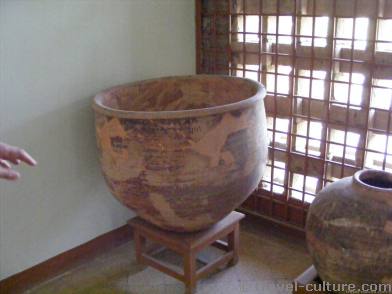History of Music in Pakistan
Music of Pakistan dates back to over 5000 years. Pakistan is the modern name of a country once was named as Sindu Supta and India (Land of Indus). This is where the great Indus civilization flourished which was rich in art, music and dance. The dancing girl and the musical pots found from Moen Jo Daro are some of the proofs of the early music of this land.
Pakistani music has evolved with many historic phases under which this land went thru. Invaders from all corners of the world brought their bits of spices to the music, culture and art of Pakistan. After the arrival of Islam and than the revolution of sufism music became ever more mature and developed a new identity of it self.
Prehistoric Music 7000 - 2500 BC
The actual music melodies are definitely unknown nor are the words of lyrics knows as the Indus script is still undecipherable, however several archeological finding suggest the existance of music in the Village Culture of Mehar Garh Amri and Kot dijian culture. In Moen jo Daro, it being an urban civilization, the music must have beel mature as we see the dancing girl and musical pots which were used as drums were found from Moen Jo Daroo and Harrappa.

Music Pots Moen Jo Daro Museum
Archaeological discoveries
Musical instruments, such as the seven-holed flute and various types of stringed instruments, have been recovered from Indus Valley Civilization archaeological sites.
Buddhist Period 275BC to 600 AD
In Gandhara art we see several images holding musical instruments and even singing, although not much is known about the songs of that time but it certainly had many elements from the ancient history. The music than would have been more in praise of Buddha and hindu dietis and heros. Greek influence as is in the art of sculptures must have been dominant on the music as well at that time
A Historical Perspective
The classical discipline of Pakistani music is a continuation of the Indo-Muslim musical tradition, which evolved as a result of centuries of Hindu-Muslim cultural interaction. Hindus possessed a rich tradition of music, but unfortunately, its history is obscure. Books on ancient Indian music such as Bharta (300 BC), Bhretdari (400 AD) and Sarangadeva (13 century AD) are so incomprehensible, and at places so contradictory, that it is impossible to discern a single comprehensible theory. However, there is a consensus among scholars that ancient Indian music began with the religious life of the Aryans, who chanted verses (ashlokas and mantras) from the Sama Veda, which the Hindus believe to be the source of all music.
Religious music in the form of chanting mantras, called Dhurpad, was the monopoly of high-caste Brahmins, who performed their religious rituals in the temples and refused to allow low-caste Hindus or Muslims to enter the temple and listen to religious music, believing this to be an act of blasphemy.
Radical change
Since the music sacred to Brahmins was kept secret, Muslims and low-caste Hindus created folk music which was different from the temple music. This music evolved some extra notes in comparison with shuddha, or pure music practices. These folk melodies caught the fancy of Muslim Sufis, who learned local languages, dialects, and melodies to communicate their teachings more effectively. They composed their mystic songs using local tunes and local diction. Since these Sufis were already schooled in Persian and Arabian music, a new fusion arose, and new forms of music evolved.
Over a period of almost eight hundred years, the emerging forms were classified on the basis of their qualitative differences in tonality and assumed names which are still familiar today: Tarana, Kheyal, Thumri, Dadra, Qawwali and Ghazal. Hazrat Amir Khusrao is credited with starting to reclassify these melodies according to the Persian muqqam system. Later, this work was continued by Sultan Hussain Sharqi of Jaunpur.
Muslim musicians were the torchbearers of high-quality creative music and often received generous patronage at the courts of both Muslim rulers and Hindu Rajas. During the reign of Sultan Muhammad Bin Toughlak (1325-1351 AD), music was patronized on a grand scale. The Sultan is reported to have kept 1,200 musicians in his service. Others renowned for their patronage of music were Ibrahim Shah Sharqi of Jaunpur (1401-1440) and Sultan Zainul Abedin of Kashmir (1416-1467 AD). The glory of music reached its zenith during the Mughal reign of Akbar, Jehangir, Shahjehan, and their successors. Mian Tansen, Baz Bahadur, Meera Bai, and many other famous musicians of Akbar's period made their mark on history.
The unhindered flowering of music in Muslim India, and the involvement of a large number of Muslims in the evolution of music, culminated in the emergence of several gharanas (schools or families) of music which are still in existence.
Evolution Of Gharanas
A gharana is a school of thought in subcontinental classical music. The emergence of the gharana system has its roots in the ustad-shagird (teacher-student) relationship which is the hallmark of this musical tradition, shaping the personality and character of future generations of musician and ensuring continuity of the musical tradition.
The main feature of this highly personalized system is that an accomplished musician takes on the responsibility of training one student at a time. This person is often a son or daughter, or a very close relative. The teacher imparts musical knowledge and assists in the culturing of the disciple's voice with meticulous care and unwavering patience. This long process of talim (training) goes on for many years until the teacher is completely satisfied.
There are nine authentic gharanas acknowledged in the world of music. They are: Dehli, Agra, Kirana, Gwalior, Patiala, Talwandi, Qawwal Bachon Ka, Kapoor Thala, and Sham Chorasi. These gharanas evolved during the period of Muslim rule in India, when most of the court musicians were followers of the Islamic faith. These gharanas continued to flourish even under the patronage of Hindu princes, producing musicians of such great fame and calibre as Abdul Karim Khan and Abdul Wahid Khan (Kirana), Fateh Ali Khan and Bade Ghulam Ali Khan (Patiala), Amir Khan (Indore), and Fayyaz Khan (Agra).
Each gharana has its own way of presenting a raga, called gharana gaiki (the family style of singing). Different ways of voice production also separate one gharana from another.
Classification of Classical Music of Pakistan
In the 16th century, Mian Tansen, an outstanding and vital figure in music, discovered that there were nearly 4,000 ragas. He analyzed each and every one and discarded those which were spurious or repetitious creations, thus reducing the number of melodies to some 400. Scholars generally agree that it was Tansen who perfected the Indo-Muslim style of singing which later became known as dhurpad. The scientific classification of classical music comprises a number of thaths (scales), under which fall the various ragas or tunes. Different styles of singing prevail in different parts of the subcontinent: the South Indian style, the Maharashtrian style, the Patiala style, and others. In Pakistan today, the Patiala style is the most prevalent.
During the Mughal period, a great deal of Persian and Arabian music was incorporated into the subcontinent's classical music system, improving the quality of Indian music. Today, the favorite ragas in Indian subcontinent are the ones invented by Muslims, such as Darbari, Mian Ki Malhar, and Mian Ki Todi. These ragas express the mood of different times of the day and different seasons, and are thus sung at specific times. For example, Bahar is sung in the spring, while Malhar is sung during the monsoon season.
Kheyal
The kheyal style of singing, which has reigned supreme in the domain of classical music in the subcontinent since the 18th century, is the most important form of musical composition. Deeply steeped in Muslim traditions, it took almost 500 years for this genre to reach its pinnacle of success and glory. It grew side by side with dhurpad, but ultimately eclipsed it.
Like several other musical genres (qawwali, kafi, ghazal), kheyal is unquestionably a Muslim innovation which has completely revolutionized the music of this part of the world. Hazrat Amir Khusrao's reclassification of subcontinental ragas according to the Persian muqqam system served as the natural womb out of which kheyal was born.
Sultan Hussain (1451-1500), the king of Jaunpur, made invaluable contributions to its nourishment, Sultan Hussain's study of music was deep. Like a professional singer, he underwent rigorous training for many years. He made his mark in the world of music, composing several new ragas and earning recognition as one of the pioneers of the kheyal form of musical expression. However, it is generally agreed that this supreme expression of Muslim musical genius reached its acme during the period of Muhammad Shah Rangeela (1719-1748). Credit for perfecting the style goes to Naimat Khan Sadarang, the court musician of Muhammad Shah Rangeela.
Kheyal literally means fancy or imagination, to visualize a thing in respect of its structural and emotional aspects. This form of music is so named because it is inherently imaginative in its subject matter, interpretation, and treatment. The musical composition ofkheyal is full of grace. Simple, straight notes are rarely used; some form of modulation enters into every melodic phrase. This style of singing predominates in Pakistan, northern India, and Bangladesh. Some vocalists in Afghanistan have also adopted it. There are several schools (gharanas) of kheyal exponents which are known for their distinct styles of singing, aesthetic approach, and methods of voice production. Prominent among them are Patiala, Talwandi, Gwalior, Delhi, Agra, Kirana and Jaipur. Some of the greatest kheyal singers of the 20th century have been Abdul Karim Khan (Kirana), Amir Khan (Indore), and Bari Ghulam Ali Khan (Patiala).
Dhurpad
Music has always occupied a very high place in Hindu worship. All forms of classical music were used as adjuncts in the performance of religious rites.
Raja Maan Singh Tomaar of Gwalior (1486-1526), with the help of his court musicians, took upon himself the task of establishing some order in the jungle of music. He changed the style of devotional music by injecting it with such mundane subjects as human love. Until then, only spiritual topics had been addressed. This new style became known as dhurpad. Of all the styles of singing,dhurpad is considered the most manly, arduous, and effective in communicating deep emotions and pathos.
Like any other genre of music, dhurpad has strengths and weaknesses. Its strongest feature is the strict adherence of its exponents to the two basic principles of rhythmic advance and progression by determinate degrees. The constant aim of the performer is to create the maximum possible effect with a few simple, clean notes unaccompanied by any flourishes, shakes, or similar touches of grace. Its main weakness, however, is the monotonous repetition of notes and strict avoidance of the use of ornamentation.
The past 800 years have produced great dhurpad singers who were honoured and rewarded lavishly by the royal courts. The legendary Mian Tansen was one of the most popular exponents of this genre. However, this style of singing is swiftly vanishing from the musical ethos.
Surviving music
The Samaveda, one of the ancient core Hindu scriptures known as the Vedas, consists of a collection (samhita) of hymns, portions of hymns and detached verses, all but 75 of which are taken from the Rigveda. They were intended to be sung using melodies called Samagana whose musical forms are indicated. These hymns were sung by Udgatar priests at sacrifices in which the juice of the Soma plant, clarified and mixed with milk and other ingredients, were offered in libation to various deities. This memorization by Hindu priests of the sacred Vedas included up to eleven musical forms of recitation that could be used on the same text.
Echoes in modern Indian music
Contemporary South Asian and Indian music has its roots in the prehistoric era of Indian and South Asian culture.
Nātya Shastra
The Nātya Shastra is an ancient Indian treatise on the performing arts,
embracing Indian theatre, early Indian classical dance and Indian classical
music. It was written between 200 BC and 200 AD, during the classical period of
Indian history. This text, which contains 6000 shlokas, is attributed to a muni
whose name was Bharata Muni.
The Nātya Shastra is based upon a much older text called the Nātya Veda, which
contained 36,000 shlokas.[1] No copies of the Nātya Veda have survived. Some
scholars believe that it may have been written by various authors over a period
of time
This site contains information & guide to every city of Pakistan. News articles and a lot of information. Please click the related links below.
Pakistan Profile (Basic information about Pakistan
Population, GDP Geography etc.)
Flag of Pakistan, Map of Pakistan
Maps of Pakistan
History of Pakistan (Chronological history of Pakistan) Archeology of Pakistan
Old Punjab Images
Museums in Pakistan
Provinces (Information about the culture of each
province)
Distances between major cities of Pakistan
Weather information
Airports of Pakistan.
Land communication (Railroads & Highways)
Gardens in Pakistan
Mountains of Pakistan
Pakistan Currency Notes
Hotels In Pakistan.
Custom Rules in Pakistan Baggage Rules
Import of personal vehicles
Punjabi Sufi Poetry
Sindhi Sufi Poetry
Music Of Pakistan
Urdu phrases for Tourists
Advertisement
Advertise on this site click for advertising rates





Kaghan Hotels

Pakistan Tours for Chinese
Tours for Tourists from Thailand
Our Other offices
Dubai Travel & Culture Offerring Tours, Desert Safaris and hotels in Dubai
Sri-Lanka Tours Our Colombo office operating tours in Sri Lanka
Qatar Travel & Culture Tours and travel information about Qatar
Malaysia Travel & Culture Tours and hotels in Malaysia
中文网站 Read this website in Chinese
More offices Details about our company and other offices
